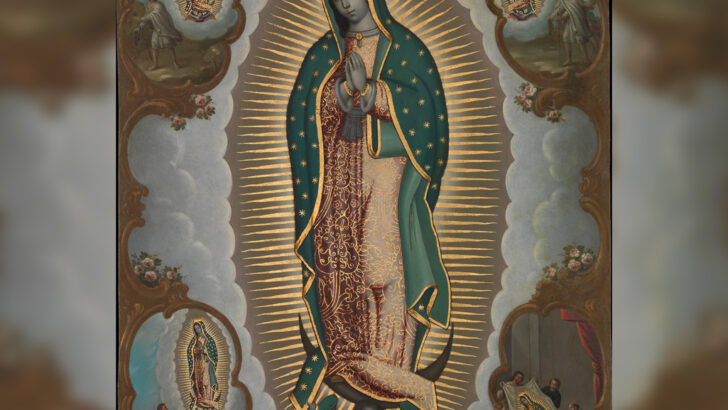Like the Shroud of Turin, the sacred object for The Virgin of Guadalupe is a piece of fabric, with an image imprint believed to be miraculous. The Patron of the Americas and Queen of Mexico, Our Lady of Guadalupe presented herself as the Mother of God on a Mexican hill in the 16th Century.
Juan Diego Cuauhtlatoatzin was an Aztec indigenous, with a conflicting background. Some historians believe he was just a humble peasant, while others contend there is evidence he was an Aztec prince. It is believed he saw the Virgin four times, twice on December 9, again on December 10 and a last time on December 12.
When Juan Diego was about 50 years of age, he and his wife were amongst the first Mexican indigenous to accept baptism and convert to Christianity.
In 1531, he was on his way to Mass when he saw a glowing figure on Tepeyac Hill, on the borders of what is today Mexico City. During the first apparition, Our Lady talked to him in his native language and told him to ask the bishop to build a shrine to her on that hill.
The story says that Juan Diego went to Juan de Zumárraga, the first bishop of Mexico, and told him what he saw, but the bishop was very hesitant to believe and requested time to consider the matter.
Apparition
The second apparition happened on Juan Diego’s way home on that same day. He apologised to the Virgin and asked her to send a more honoured messenger. The Virgin told him to go back to the bishop.
On December 10, Juan Diego had visited the bishop again, who asked for proof before he would approve the construction of a church. On his way home, he saw Our Lady, told her what happened and she said the next day he should go back to the bishop and she would provide proof.
He missed the appointment on the next day, as he was taking care of his ill uncle. On December 12, when Juan Diego was looking for a priest to administer last rites to his uncle, he saw the Virgin again. This time, she told him to gather roses and take them to the bishop as proof. She also mentioned his uncle would be cured of his illness.
Even though it was winter and no flowers should be in bloom, Juan Diego found many roses on the hill, which he collected on his tilma (a simple cloak) as proof for the bishop.
When he met with the bishop for the third time, he opened his tilma and let the roses fall to the floor. The image of Mary was imprinted on the inside of the tilma. Having his proof, the bishop ordered a church to be built on the hill and Juan Diego went back to his home, where he found his uncle cured.
After the construction of the church, Juan Diego moved to a hut nearby and spent the rest of his life taking care of the pilgrims who came to the shrine. When he died, his body was buried in the church.
The existence of Juan Diego and the authenticity of the Virgin of Guadalupe were questioned many times throughout the years”
On the site of that first church, built in the 16th Century, a new one was constructed. This second church is known as the Old Basilica, it was given the status of a basilica by Pope Pius X in 1904. The Old Basilica was finished in 1709, but became dangerous when its foundations started to sink. A New Basilica was built close by and the original image of the Virgin of Guadalupe on Juan Diego’s tilma is kept in it.
The existence of Juan Diego and the authenticity of the Virgin of Guadalupe were questioned many times throughout the years. Even the former abbot of the Basilica of Guadalupe, Fr William Schulenburg, denied the historicity of Juan Diego, and argued it would be ridiculous to canonise a saint who never existed.
Similar statements were made in various occasions before, for example, Spanish academic Juan Bautista Muñoz, said on April 18, 1794 the Guadalupe event lacked historical basis.
Opposing those doubtful statements, in 1754, Pope Benedict XIV granted the Virgin of Guadalupe a Feast for December 12. On the same year, a Papal Bull declared the Virgin of Guadalupe as patroness and protector of New Spain, and in 1810 she became the symbol of Mexican independence when patriot priest Fr Miguel Hidalgo y Costilla raised her picture on his banner.
Expert
Prof. Fr Fidel Gonzalez Fernandez, who is a recognised expert in his field, was named president of a Vatican Commission aiming to proof the existence of Juan Diego and the events in Guadalupe. Prof. Fernandez was leading a group of 30 researchers from multiple nationalities.
During their research, they found 27 Guadalupe Indigenous manuscripts of documents and testimonies, and eight of mixed Spanish-Indigenous origin.
Microscopic analysis show no visible brush strokes, but revealed the existence of a reflection on the Virgin’s eye”
The main argument of those who oppose the existence of Juan Diego and consequently the visit of the Virgin is the lack of documents dating from the 20 years following the Guadalupe apparition. However, that could be the result of documents being destroyed or lost, and not necessarily their inexistence.
The Vatican accepts the historicity of Juan Diego and his sanctity. Pope John Paul II, was the responsible for the canonisation of St Juan Diego on July 31, 2002. He had beatified the new saint on May 6, 1990.
To this date, the miracle of St Juan Diego’s tilma cannot be explained by science. The cloak was made with a fabric composed by threads of maguey cactus, which normally should disintegrate in 20-60 years. However, the tilma is still preserved with the virgin image on it almost 500 years later.
Another inexplicable fact about the image on the tilma relates to its pigments, as they do not match any known colouring. Microscopic analysis show no visible brush strokes, but revealed the existence of a reflection on the Virgin’s eye, so small it would be impossible to paint by hand. Some believe that reflection of an old man is St Juan Diego.


 Renata Steffens
Renata Steffens The Virgin of Guadalupe
The Virgin of Guadalupe 